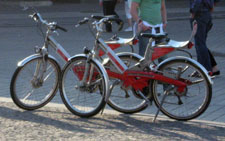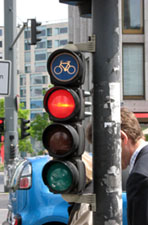Every two weeks, MPC uncovers best practices from around the world and delivers them right to your inbox in Talking Transit. This week, MPC explores how Berlin intelligently links rail, road, and bicycle transport.
Consistent with a bicycle-friendly culture in Germany, Berlin accommodates approximately 400,000 bicycle riders every day. Bicyclists currently make up 12 percent of the city’s total traffic (40% by transit) and ride throughout Berlin’s 385-miles of bike paths to work, school and home, and for other transportation needs. Cyclists have access to 43.5 miles of bus lanes, 62.1 miles of combined pedestrian/bike paths, and 31.1 miles of bike lanes on the sidewalks. Bicycles are interwoven into Berlin’s regional transportation network, which is evident by the more than 3,000 bike parking spaces at various train stations and easy connections between transit stations and bike paths. Twelve main bicycle routes extend from the city center into the suburbs and form a star-shaped network linked with eight circular routes.
Accessibility is key in Berlin, as the 4,500 bikes that make up the Deutsche Bahn’s CallBike flex system are stationed at all major crossings and railway stations within the city. The CallBike system is novel in its simplicity. The idea behind this system is that many of the trips people make inside a city both begin and end at a railway station. To utilize the CallBikes, the user calls the phone number on the bike and receives a code, via text message, to open the bike’s electronic lock. Users are charged six Euro cents a minute, and no more than 15 Euro ($21 U.S.) per day. Returning the bike is just as easy as renting it: bikers can leave it at a major intersection or locked to any stationary object within the core city area. CallBike is Berlin’s answer to lessening traffic jams and improving short-distance mobility.
In 2000, the Berlin Senate made a commitment to increase bicycle use and ensure it would make up 15 percent of the city’s total traffic by 2010. Coupled with a major international sporting event, the 2006 World Cup, and overall goals to reduce congestion, improve the environment and the health of residents, bicycles are becoming fully integrated into the city’s comprehensive transportation system. Since 2000, Berlin’s Senate has allocated about $11.5 million (U.S.) into its bicycle infrastructure. Not only has this investment improved mobility and reduced congestion in the region, but the bicycle tourism industry has increased greatly since these capital improvements were made.
The City of Chicago has invested more than $45 million dollars into creating bike lanes, racks and stations around the city. Some CTA stations have bike-accessible facilities, and Metra has added bike racks to its stations in several bike-friendly communities. However, the Chicago region still has a long way to go to create an integrated bike network like that of many European cities. We can learn from Berlin’s commitment to better bicycle infrastructure and help promote alternative modes of transportation.
This article was featured in Talking Transit, MPC's bi-weekly e-newsletter. To receive the newsletter, visit http://www.metroplanning.org/personalize.asp.